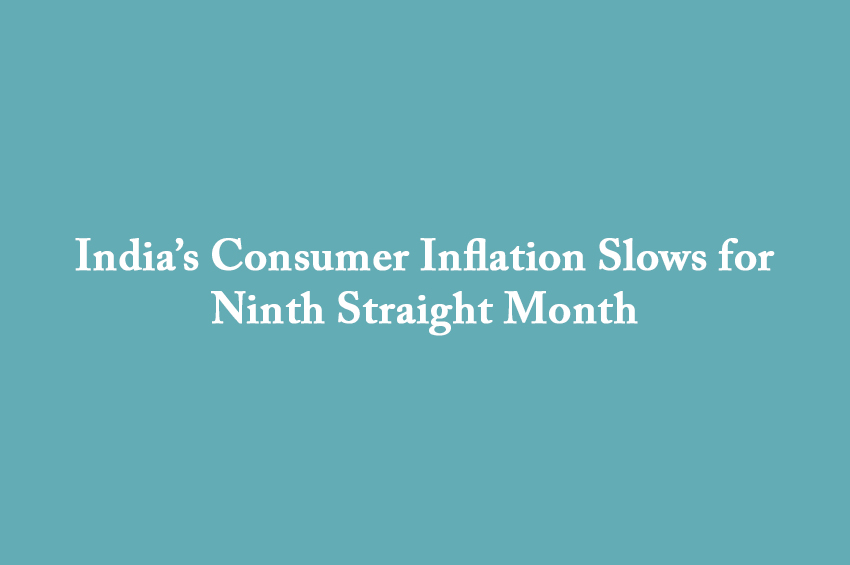Winning Bizness Economic Desk
The country’s consumer inflation continued to slide in July—the ninth consecutive month of decline—and reached 1.55 per cent.
This is inflation’s lowest level since July 2017. The southward movement in inflation is primarily because of a noteworthy decline in food prices.
Food inflation, a key component of the Consumer Price Index (CPI) came in at -1.76 per cent, lower than the June figure of -1.06 per cent.
A point to note here is that the inflation reading has come after India’s central bank, the Reserve Bank of India (RBI) held rates at 5.5 per cent in its policy meeting held in early-August.
The country’s central bank said that the inflation outlook for the financial year ending on March 31, 2026 (FY 26) “has become more benign than expected”, adding that this was due to a healthy sowing of autumn crops, as well as a comfortable buffer stock of food grains.
The Reserve Bank forecast inflation at 3.1 per cent for the current fiscal year.
Here, a point that needs highlighting is that the country’s economic growth has come in better than expected for the quarter ended March, expanding 7.4 per cent Year-on-Year (YoY).
The Reserve Bank has forecast GDP growth for the country for this fiscal at 6.5 per cent.
India Should Join RCEP, Says Jeffrey Sachs
Globally well-known American economist Mr Jeffrey Sachs has called for India to join the Regional Comprehensive Economic Partnership (RCEP). He also said that India should concentrate on East Asia to propel its economic growth.
His statement comes in the wake of the United States (US) imposing a high 50 per cent tariff on Indian goods.
The American economist said that India should be a part of the RCEP and “that would be a dynamic way to grow for years to come,” in an interview with a leading news publication.
“I would recommend India take a look once again at RCEP. RCEP is the 15 economies, including China, Japan, Korea, ASEAN, Australia and New Zealand. It should be 16. India should be part of that. And that would be a very dynamic way to grow for years to come,” Mr Sachs said.
India could target a GDP growth rate of seven per cent in the coming decade by focusing on East Asia, he said.
“India needs a strategy that does not depend on export growth to the US market…India should be achieving about seven per cent GDP growth…But to do that, trade with China…. Deepen the relations in East Asia,” he added.
It must be pointed out here that in 2019, India had decided not to join the RCEP as the agreement was not addressing its concerns.
India had then stated that the current structure of the RCEP did not reflect the RCEP guiding principles, nor did it address the outstanding issues and concerns of India.
Maharashtra, Karnataka, Gujarat Top in FDI Investments in FY 25
Foreign Direct Investment (FDI) is one of the defining factors in India’s economic trajectory. Some states and Union Territories (UTs) have managed to attract a significantly higher share of this FDI inflow into services, software, trading and manufacturing.
The country registered in excess of USD 81-billion in FDI last fiscal (FY 25). This is a very healthy increase of 14 per cent from the previous year. It is also more than double the inflow seen a decade ago.
The top three states with the highest FDI attracted are Maharashtra at USD 19,589-million, Karnataka at USD 6,619-million and Gujarat at USD 5,711-million.
Delhi and Tamil Nadu come in at fourth and fifth. Delhi attracted USD 6,091-million and Tamil Nadu USD 3,681-million. At sixth place is Haryana with USD 3,147-million.
After that the four positions up to the tenth are occupied by Telangana (USD 2,994-million), Uttar Pradesh (USD 436-million), Rajasthan (374-million) and Jharkhand (USD 7-million).
There are two channels of investing through the FDI route in the country—the automatic route and the government route.
In the automatic route, foreign investors do not need prior government approval. What this means is they can invest directly by partnering with Indian entities setting up subsidiaries or establishing green-field businesses.
Manufacturing, services, telecom and retail fall under this category. However, for sectors such as defence, media and mining, investments must go through the government route, which involves approval from the concerned ministries.
Investors can bring in capital by subscribing to the Memorandum of Association (MoA), private placements, mergers or demergers, share purchases, rights or bonus issues or even swapping capital instruments and convertible notes.
The country’s apex bank, the Reserve Bank of India (RBI) and the Department for Promotion of Industry and Internal Trade (DPIIT) track and regulate the flow and compliance.
In India, some of the top FDI contributors are from the United States, Japan, Mauritius, Singapore and the Netherlands.
Defence, Space Tech Cos Eye Tuticorin for Investments
Tuticorin district in Tamil Nadu is attracting investments from defence and space tech companies. The district is fast shaping up to become the space and defence tech hub of Tamil Nadu.
The hub is getting investments of around Rs 5,600-crore in both the defence and space tech segments. The important investments are from those of the well-known Sakthi Group and start-ups such as Agnikul Cosmos and Ethereal Exploration Guild.
It is also expected that these investments will create in excess of 3,000 jobs.
Sakthi Group’s is reported to be the biggest investment—the group plans to establish a manufacturing-cum-proof-testing facility for ammunition and propellants in the district.
The committed investment is to the tune of Rs 5,000-crore. This project is expected to provide employment to around 2,000 people.
Another company, Ethereal Exploration Guild, a space-tech start-up will be setting-up a manufacturing and testing facility for medium lift rocket engine in Tuticorin.
The project will entail an investment of Rs 519-crore and an employment commitment of around 582 jobs.
Agnikul Cosmos is another company which plans to invest in Tuticorin. It plans to set-up a facility for manufacturing and testing of rocket launch vehicles for satellites in the district.
In its recently released space tech policy, the state government had set a target of attracting Rs 10,000-crore investments in the space sector in the next five-years besides help create direct and indirect employment for nearly 10,000 people.
Tamil Nadu is also working towards creating a skilled talent pool for the space sector over the next five-years.
An important point to note here is that the Indian Space Research Organisation (ISRO) is setting up its second space port in Kulasekarapattinam in Tuticorin which makes the district ideal for attracting investments in the defence and space tech segments.
Top Industrialist Lists Priorities to Tackle US Tariffs
Top industrialist and chairman of RPG enterprises Mr Harsh Goenka has listed what he terms as priorities for how India can tackle the 50 per cent tariffs imposed by the United States on Indian products.
Mr Goenka said that the country should take steps to “boost tourism earnings aggressively” through global campaigns, visa-on-arrival schemes and cleaner tourist places.
He called for creating a fund to assist exporters find new markets and to “deepen trade with the EU, ASEAN, Africa and Latin America” to reduce dependence on the United States.
If the US tariffs continue to stay, then India must, in addition to the above, strive to push high-value services exports such as IT, consulting, fin-tech in addition to attracting manufacturing shifting out of China, Mr Goenka said.
The country must also incentivise domestic R&D for import substitutes, Mr Goenka pointed out.
Two other things the country must prioritise, he said, are to “expand agricultural exports via value-addition and branding” and “promote Indian culture, wellness and Ayurveda exports.”
According to the RPG Enterprises chairman, India must also “build logistics and port efficiency to cut export costs.”
“Tariffs can block goods, not our resolve,” Mr Goenka said.
The US had recently imposed a 50 per cent tariff on Indian products because India was purchasing oil and weapons from Russia. India has criticised the American tariff imposition calling it “unfair, unjustified and unreasonable”.


